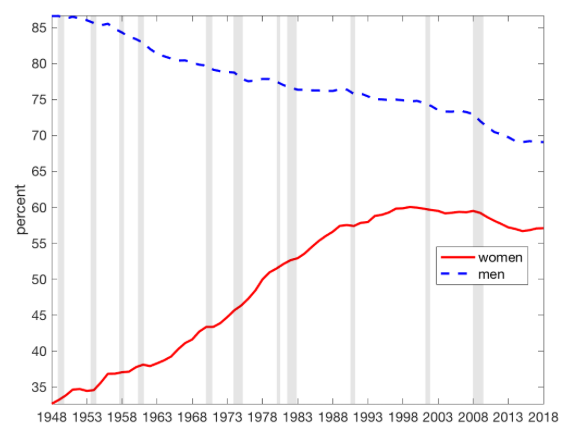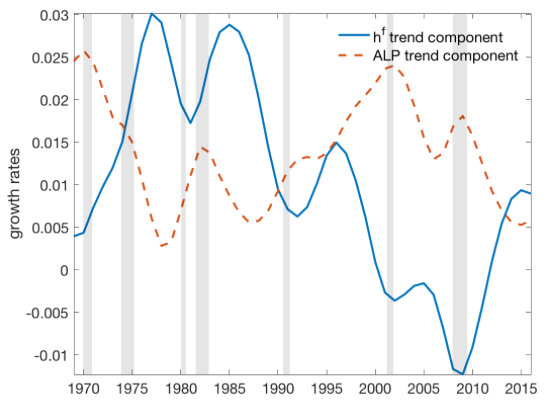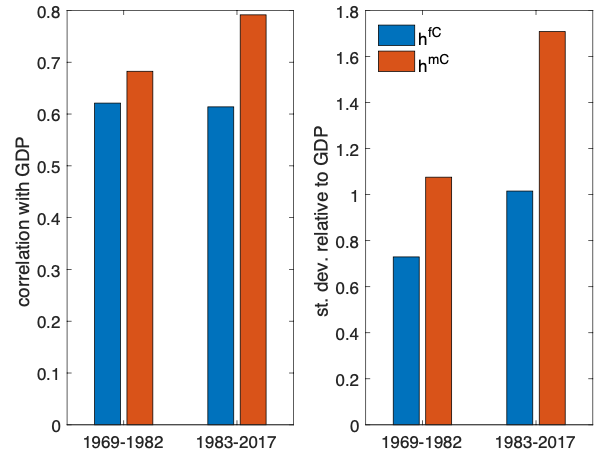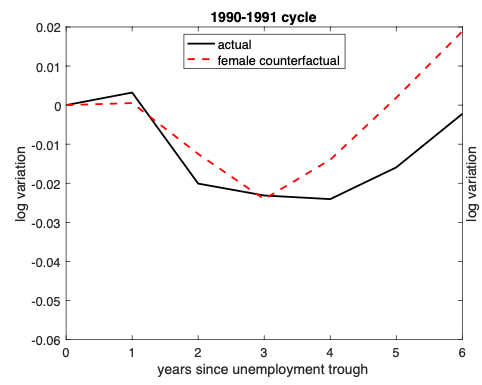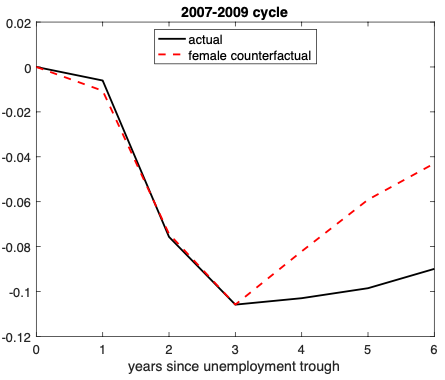The rise in women’s market work is one of the most notable economic developments in the post-war United States. Female participation rose from 37% in 1960 to a peak of 61% in 1997, and then flattened out, as shown in Figure 1. This phenomenon contributed substantially to the rise in aggregate hours per person in the US in the 1970s and 1980s. While a large literature has studied the determinants of the rise in women’s employment, the implications of this phenomenon for the aggregate performance of the US economy have been left largely unexplored. At the same time, several key properties of US business cycles changed over this period, and economists have yet to provide a comprehensive explanation of those changes. Three particularly puzzling phenomena stand out:
- the productivity slowdown in the 1970s (Jorgenson 1988) and the decline in the cyclical correlation between aggregate per capita hours and productivity (Gali and Gambetti 2009);
- the decline in the cyclicality of output and aggregate hours starting in the early 1980s, known as the Great Moderation (Stock and Watson 2002); and
- the sluggish growth in employment in the aftermath of recessions starting in the early 1990s, often referred to as jobless recoveries (Graetz and Michaels 2017).
Figure 1 Labour force participation by gender, working age population
Source: Author’s calculations based on Current Population Survey.
In my research, I propose that the steep rise in women’s labour force participation throughout the 1970s and 1980s, and its flattening out since the early 1990s, can help explain these developments (Albanesi 2019). My analysis is based on new empirical evidence that uses micro data on hours per capita and wages by gender, as well as a quantitative analysis based on a theoretical model of business cycles that incorporates gender. The model is the simplest possible departure from a standard real business cycle model, used broadly for the analysis of economic fluctuations by both scholars and policymakers.
Gender differences enter in two ways. The representative household is made up of female and male individuals, reflecting their distribution in the US population. Women and men in the model have different and time-varying disutility from working, to match the rise and stabilisation of female labour force participation and the steady decline of male participation. The disutility from labour acts as a reduced form proxy for structural factors affecting the labour supply of men and women. Specifically, a decline in the disutility of labour for women reflects the medical and technological advances that have been shown to be critical to the rise in female participation. These include the diffusion of oral contraception (Goldin and Katz 2002), the improvement in maternal health and the introduction of infant formula (Albanesi and Olivetti 2016), and the adoption of home appliances (Greenwood et al. 2005). Additionally, women’s Frisch elasticity of labour supply is three times as high as that of men’s, reflecting empirical evidence (Blundell and MaCurdy 1999).
On the production side, firms operate a neoclassical technology, in which labour input aggregates female and male hours, which are imperfect substitutes. Women’s and men’s productivity may differ and varies over time. Differences in labour productivity by gender reflect the skill composition of female and male workers, as well as their labour market experience. Female workers were typically less educated and had lower levels of experience compared to make workers in the 1960s and 1970s, but they caught up rapidly along both dimensions. Since the mid-1990s, women in the workforce have had higher levels of educational attainment than men on average (Blau and Khan 1997, Olivetti 2006). The model can be used to account for the various forces driving economic performance, including the role of gender.
Productivity dynamics
The productivity slowdown—that is, the decline in the growth rate of average labour productivity, defined as output per hour—started by most accounts in the early 1970s in the US. Except for a brief reprisal in the mid- to late-1990s, productivity growth has been slow since. It is fair to say that the source of this slowdown remains a puzzle, though the most plausible explanations point to the role of demographics and technology (Fernald 2015).
Figure 2 plots the trend components of the growth rate of average labour productivity (ALP) and female hours from 1969. There is a clear negative relationship between these two variables, which is particularly pronounced before 1995. Since women’s hours increase significantly over this period, it is not surprising that there would be a decline in output per hour, particularly as women in the workforce tended to have lower levels of education and experience than men at the time. I show that despite this, the growth in female hours contributed positively to the growth rate in total factor productivity (TFP) throughout the sample period, due to the steady rise in women’s productivity relative to men (Albanesi 2019). Moreover, starting in the 2000s, women workers also contribute positively to average labour productivity, as their hours stop growing but their productivity continues to rise relative to men’s. Going forward, there is every reason to believe that women’s contribution to productivity growth will continue to be positive, as their educational attainment and work experience increase further.
This study also shows that the contribution of women’s hours to average labour productivity is strongly countercyclical (Albanesi 2019), and this can account for a large fraction of the decline in the cyclicality of ALP that began in the late 1970s (Gali and Gambetti 2009).
Figure 2 Female hours per capita and average labour productivity (ALP) trend components
Source: Author’s calculations based on Current Population Survey.
The Great Moderation
Starting in 1983, there was a sizable reduction in the cyclical volatility of aggregate hours per capita, GDP, and other aggregate variables. Most of the literature on this subject has focused on the role of smaller shocks or improved stabilisation policies (Davis and Kahn 2008). I argue that the rise in women’s share of aggregate hours contributed to this development via two main channels (Albanesi 2019). First, women’s hours are considerably less cyclical than men’s hours. They display comparatively lower contemporaneous correlation with GDP and lower standard deviation relative to GDP, as can be seen in Figure 3. Much of this difference is due to the added worker effect (Lundberg 1985); that is, the fact that married women’s participation tends to rise during recessions in response to the heightened risk of job loss for husbands, a mechanism reflecting household insurance (Albanesi 2019). This model also shows that absent this force, women’s hours, and therefore aggregate hours, would be significantly more cyclical in the period corresponding to the Great Moderation (Albanesi 2019).
Figure 3 Cyclical components of hours per capita by gender (contemporaneous correlation with and ratio of standard deviation to cyclical component of GDP)
Source: Author’s calculations based on Current Population Survey.
Jobless recoveries
Starting with the 1991 cycle, the US economy experienced very sluggish recovery of employment and hours in the aftermath of recessions. The leading explanations centre on the role of structural change – particularly the decline in manufacturing (Groshen and Potter 2003) and job polarisation (Jaimovich and Siu 2012). While these phenomena reflect secular forces, most of the resulting job losses occurred in recessions, leading to a permanent drop in employment. If this were the only explanation for jobless recoveries, we should observe lower job-finding rates for manufacturing and routine workers laid off in recessions, and higher rates of transition for these workers into services and non-routine occupations. Earlier work shows that this is not the case, suggesting that other forces are also at work (Albanesi et al. 2013).
My new study points out that recoveries have always been jobless for male workers, while a substantial change in the behaviour of women workers takes place during recoveries (Albanesi 2019). As long as female participation was rising, women experienced very small drops in their hours during recessions and very fast growth in their hours during recoveries. By contrast, after female participation stopped increasing, the growth in women’s hours during recoveries resembled men’s. To quantify the role of the changes in women’s behaviour, I calculate the counterfactual path of aggregate hours per capita that forced women’s hours to behave in recessions and expansions as they did, on average, when their participation was rising (displayed in Figure 4). Clearly, the counterfactual series for aggregate hours per capita shows very strong recoveries for the 1990-1991 and 2001 cycles, and a stronger recovery after the 2007-2009 recession.
This study also shows that if female participation had continued to rise, not only would jobless recoveries have been avoided, but overall economic performance would have been much stronger (Albanesi 2019).
Figure 4 Actual and counterfactual aggregate hours per capita
Source: Author’s calculations based on Current Population Survey.
Summary
The changing trend in women’s participation can rationalise and link three phenomena that have affected US economic performance in the last four decades: the productivity slowdown, the Great Moderation, and jobless recoveries. Most existing explanations for these phenomena focus on the role of technological change. My study shows that labour supply forces, and in particular the rise and stabilisation of women’s participation, are also critical and can resolve questions left open by explanations that exclusively rely on labour demand (Albanesi 2019). These results suggest that excluding gender differences in aggregate models of the US economy can hamper our understanding of key economic drivers of economic performance and business cycle behaviour.
References
Albanesi, S (2019), “Changing Business Cycles: The Role of Women’s Employment”, CEPR Discussion Paper 13578.
Albanesi, S and C Olivetti (2016), “Gender roles and medical progress”, Journal of Political Economy 124(3): 650-695.
Albanesi, S, V Gregory, C Patterson, and A Sahin (2013), “Is Job Polarization Holding Back the Labor Market?”, Liberty Street Economics, Federal Reserve Bank of New York.
Blau, F D and L M Kahn (1997), “Swimming upstream: Trends in the gender wage differential in the 1980s”, Journal of labor Economics 15(1, Part 1): 1-42.
Blundell, R and T MaCurdy (1999), “Labor Supply: A Review of Alternative Approaches”, Handbook of Labor Economics, Volume 3, Edited by O Ashenfelter and D Card, Elsevier Science.
Davis, S J and J A Kahn (2008), “Interpreting the great moderation: Changes in the volatility of economic activity at the macro and micro levels”, Journal of Economic Perspectives 22(4): 155-80.
Fernald, J G (2015), “Productivity and Potential Output before, during, and after the Great Recession”, NBER Macroeconomics Annual 29(1): 1-51.
Galí, J and L Gambetti (2009), “On the sources of the great moderation”, American Economic Journal: Macroeconomics, 1(1): 26-57.
Goldin, C and Katz, L F (2002), “The power of the pill: Oral contraceptives and women’s career and marriage decisions”, Journal of Political Economy 110(4): 730-770.
Graetz, G and G Michaels (2017), “Is modern technology responsible for jobless recoveries?”, American Economic Review 107(5): 168-73.
Greenwood, J, A Seshadri, and M Yorukoglu (2005), “Engines of liberation”, The Review of Economic Studies 72(1): 109-133.
Groshen, E L and S Potter (2003), “Has structural change contributed to a jobless recovery?”, Current Issues in Economics and Finance 9(8).
Jaimovich, N and H E Siu (2009), “The young, the old, and the restless: Demographics and business cycle volatility”, American Economic Review 99(3): 804-26.
Jaimovich, N and H E Siu, H E (2012), "The trend is the cycle: Job polarization and jobless recoveries", NBER Working Paper No. 18334.
Jorgenson, D W (1988), “Productivity and postwar US economic growth”, Journal of Economic Perspectives 2(4): 23-41.
Lundberg, S (1985), “The added worker effect”, Journal of Labor Economics 3(1, Part 1): 11-37.
Olivetti, C (2006) “Changes in women’s hours of market work: The role of returns to experience”, Review of Economic Dynamics 9(4): 557-587.
Stock, J H and M W Watson (2002), “Has the business cycle changed and why?”, NBER Macroeconomics Annual 17: 159-218.

